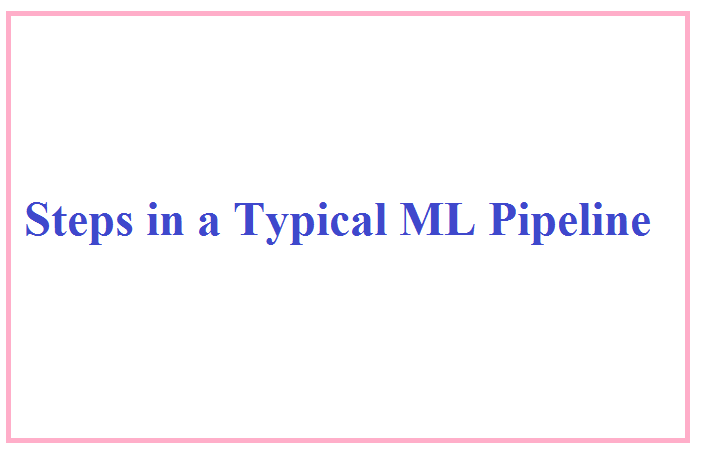Steps In A Typical ML Pipeline
Category: MACHINELEARNING | 16th July 2025, Wednesday

A Machine Learning Pipeline Is A Sequence Of Stages Through Which Raw Data Is Transformed Into A Deployable Predictive Model. Each Step Is Crucial And Interdependent. Here's A Breakdown Of The Major Phases:
1. Problem Definition
Before Writing Any Code Or Collecting Data, Clearly Define The goal Of The ML Task.
-
Is It classification, regression, clustering, Or recommendation?
-
What Are The business Or Research Objectives?
-
Define inputs (features) And outputs (targets).
Example: Predicting House Prices (regression) Or Detecting Spam Emails (classification).
2. Data Collection
Gather Data From Relevant Sources:
-
Structured Data: Databases, CSV Files, APIs.
-
Unstructured Data: Images, Text, Audio.
-
Real-time Data: IoT Devices, Web Scraping, Sensors.
Data Should Be Relevant, Sufficient In Quantity, And Representative Of Real-world Scenarios.
3. Data Preprocessing
Raw Data Is Rarely Clean Or Directly Usable. Preprocessing Includes:
a. Cleaning
-
Handling missing Values (e.g., Imputation).
-
Removing duplicates, Correcting outliers, And Fixing inconsistencies.
b. Transformation
-
Encoding Categorical Variables (One-Hot, Label Encoding).
-
Scaling Or normalizing Numerical Features (Min-Max, StandardScaler).
-
Text Vectorization (TF-IDF, Word Embeddings).
c. Feature Engineering
-
Creating New Informative Features.
-
Reducing Dimensionality (e.g., PCA).
-
Feature Selection To Remove Noise.
4. Splitting The Dataset
Divide The Dataset Into:
-
Training Set (usually 60-80%): Used To Train The Model.
-
Validation Set (optional): Tune Hyperparameters.
-
Test Set (20-30%): Evaluate Model Performance On Unseen Data.
5. Model Selection
Choose An Appropriate ML Algorithm Based On:
-
Nature Of The Task (classification, Regression, Clustering).
-
Data Size And Quality.
-
Performance Metrics And interpretability Needs.
Examples:
Logistic Regression, SVM For Classification
Linear Regression, Random Forest For Regression
K-Means, DBSCAN For Clustering
LSTM, CNN For Sequential/image Data
6. Model Training
Fit The Chosen Algorithm On The Training Data.
-
Use supervised Learning (with Labeled Data) Or unsupervised Learning (without Labels).
-
Optimize The Model Using loss Functions (e.g., MSE, Cross-entropy).
-
Choose The Right optimizer (e.g., SGD, Adam) For Deep Learning Models.
7. Model Evaluation
Assess The Trained Model Using The test Data.
Common Evaluation Metrics:
-
Classification: Accuracy, Precision, Recall, F1-Score, ROC-AUC.
-
Regression: RMSE, MAE, R² Score.
Use confusion Matrices, residual Plots, Or ROC Curves For Analysis.
8. Hyperparameter Tuning
Fine-tune The Model By Adjusting hyperparameters:
-
Use Techniques Like Grid Search, Random Search, Or Bayesian Optimization.
-
Cross-validation (e.g., K-Fold) Helps Prevent Overfitting During Tuning.
9. Model Deployment
Make The Model Available For Real-world Use:
-
Use APIs (Flask, FastAPI), Cloud Services (AWS, Azure), Or Mobile Apps.
-
Monitor Performance With logging And alerting Systems.
-
Regularly Update The Model If Concept Drift Occurs (data Distribution Changes Over Time).
10. Monitoring And Maintenance
Once Deployed, The Model Must Be:
-
Monitored For Performance Degradation.
-
Re-trained Periodically With New Data.
-
Audited For Fairness, Bias, And Security Vulnerabilities (e.g., Adversarial Attacks).
Summary Diagram
Problem Definition
↓
Data Collection
↓
Data Preprocessing
↓
Data Splitting
↓
Model Selection
↓
Model Training
↓
Model Evaluation
↓
Hyperparameter Tuning
↓
Deployment
↓
Monitoring & Maintenance
A Typical Machine Learning Pipeline Consists Of Several Key Steps. It Begins With problem Definition, Followed By data Collection From Various Sources. The Data Is Then preprocessed Through Cleaning, Transformation, And Feature Engineering. Next, The Dataset Is split Into Training And Testing Sets. Appropriate models Are Selected And trained On The Training Data. The Model’s Performance Is evaluated Using Suitable Metrics. Hyperparameters Are Tuned To Optimize Accuracy. Once Satisfied, The Model Is deployed In A Production Environment. Finally, monitoring And Maintenance Ensure The Model Remains Accurate And Reliable Over Time, Adapting To New Data Or Changes In Context.
Tags:
Steps In A Typical ML Pipeline
